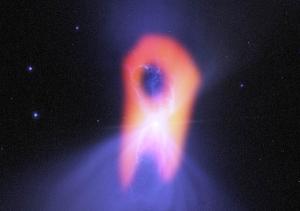Blog
Cool Cool Cool
9 September 2019
 Bill Saxton/NRAO/AUI/NSF/NASA/Hubble/ Raghvendra Sahai.
Bill Saxton/NRAO/AUI/NSF/NASA/Hubble/ Raghvendra Sahai.The universe basks in the glow of the cosmic microwave background. This remnant of the primordial fireball once warmed the cosmos to a temperature of several thousand degrees, but as the universe expanded and cooled, it now has a temperature of about 2.7 K. The background is faint and cool, but it still gives all the interstellar gas and dust just a bit of warmth. Because of the cosmic background, 2.7 K is typically the coldest deep space can be. Most objects are even warmer. Heated not just by the background, but by stars, supernovae, and other cosmic radiation.
On Earth we can create much cooler temperatures in the lab. Thus far we’ve been able to cool material to a tiny fraction of a kelvin above absolute zero, making the cosmic background seem like a sauna in comparison. But these lab experiments require sophisticated refrigeration systems specifically designed to both cool material and prevent heat from getting to it. In nature, it’s difficult to have similar conditions.
But it isn’t impossible. About 5,000 light years from Earth is a dying star known as the Boomerang Nebula. As the star furiously burns to keep itself from collapsing under its own weight, it is shedding outer layers. As a result, gas and dust speed away from the star at about 164 km/s. As the gas speeds away from the star it also expands, and gas cools as it expands.
You have used this effect if you have ever blown on a morsel of food before eating it. You pucker your lips and blow, and as the air leaves your mouth it expands, getting colder. This lets the air capture some of the heat from your food so you won’t burn your tongue when you eat it. A similar thing is happening in the Boomerang Nebula. The expanding gas drops the temperature of regions in the nebula.
In 1995, radio observations from the ESO Submillimeter Telescope found that the nebula has a temperature of only 1 Kelvin. In 2013, observations by ALMA1 imaged these cold regions in the nebula, as seen above. This not only confirmed the temperature of the nebula, but found that the outer region of the nebula is gradually warming due to the cosmic background.
As far as we know, the coldest spot in the universe is still in a lab on Earth, but the Boomerang Nebula is the coldest naturally occurring region in the universe. It is literally colder than deep space, which is pretty cool.
Sahai, R., et al. “ALMA Observations of the Coldest Place in the Universe: The Boomerang Nebula.” The Astrophysical Journal 777.2 (2013): 92. ↩︎